| After
1931, Japanese Colonial Government promoted a jinja establishement
movement called ¡§One Jinja in Each Villiage.¡¨ Since that
time, almost two hundred jinjas were established. The function
of jinjas in Taiwan was to make it a center for social sermon
to replace the role of traditional Taiwanese temples, which
used to be the society's spiritual center.
Architecture of Japanese
Jinja
Jinja is actually the Japanese pronunciation for ¡§Japanese
shrines¡¨. Jinjas built in Taiwan during Japanese Occupation
were politically, nationally, and religiously oriented. Jinja
contained strong and rich cultural elements, even its architectural
style is an important part of Japanese culture. Major constituent
structures of jinja are honden (¡§main halls¡¨ for worshipping),
structures with names such as heiden and noritoya used for
festivals, shrine offices, harai(meaning ¡§purification,¡¨
a place for washing hands and rinsing mouth) together with
torii(symbolic gate-like structures) and other sacrifice offerings.
The
Function of Huguo Jinja
In 1901, on the current location of Grand Hotel, Japanese built
the first State Shinto(Imperial House Shinto) in Taiwan¡ÐTaiwan
Shrine to enshrine Amaterasu(she is the goddess of the sun as
well as the purported ancestress of the Imperial Household of
Japan. Her full name means ¡§Great Goddess¡¨ or ¡§Great Spirit
Who Shines in the Heavens¡¨) and the first Japanese royal member
who died overseas, Yoshihisa Shinnoh, who died in suppressing
Taiwanese resistance against Japan. Taiwan Shrine is the highest
ranking Jinja in Taiwan. As for the other Japanese policemen
and soldiers who died in Taiwan, since they weren't royal members,
they couldn't be enshrined in Taiwan Shrine. Thus Japanese Government
built Taiwan Huguo Jinja in Dazhi Village nearby Taiwan Shrine
to enshrine Japanese military officers and government officials.
Taiwan Huguo Jinja was established in 1942, taken over by National
Government in 1945. Later it was reconstructed as Martyrs' Shrine.
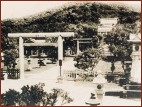 |
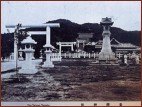 |
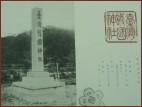 |
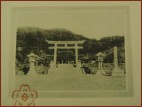 |
| Taiwan
Shrine (current location of Grand Hotel) |
Taiwan
Huguo Jinja (current location of National Revolutionary
Martyrs' Shrine) |
| Source:
Taiwan Memory Digital Photo Museum |
Source:
Taiwan Huguo Jinja |
Building
Huguo Jinja
In 1941, Japanese Government decided to build Taiwan Huguo Jinja
on the current location of Martyrs' Shrine. On January 1st,
1942, Zen-Zou Sacrifice was held. In May, 1942, Taiwan Huguo
Jinja was completed.
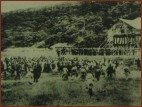 |
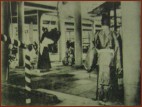 |
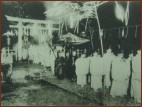 |
 |
| Sacrifice
activity for spreading biscuits and money |
Sacrifice
activity for foundation laying. |
Sacrifice
activity to call back the souls of the dead |
Japanese
Governor General Officiating the sacrifice activity |
| Source:
Taiwan Huguo Jinja, Library of Tainan Second Senior High
School |
Precious
photos of Taiwan Huguo Jinja
The following four photos were taken from the database of the
Office of Taiwan Governor-General. The Office of Taiwan Governor-General
kept a complete record of different Sacrifices, including inventory
of offerings and budgets. The other photo was taken from the
book Images of My Motherland, depicting history of Taiwanese
Images.
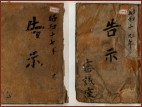 |
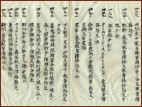 |
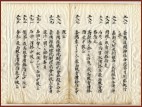 |
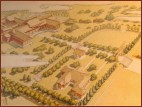 |
| Notice
of Sacrifices held in Huguo Jinja |
Inventory
record for sacrifice activities |
Joint
Sacrifice in Huguo Jinja, 1944 |
Painting
of Huguo Jinja |
| Source:
Database of the Office of Taiwan Governor-General |
Source: Images
of My Motherland |
The following four photos are found
in 2005 Online Database of Taipei City, Airiti. These photos
are of great historical value. They depict late President Chiang
officiating national memorial and the process of enshrinement.
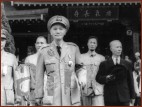 |
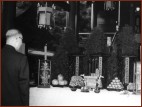 |
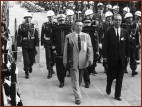 |
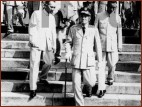 |
| President
Chiang Kai-shek and Vice President walking out of Martyrs'
Shrine after Autumn National Memorial on Sep. 3rd, 1958 |
Three Generals
were enshrined, officiated by Minister Tien on Mar. 28th,
1959. |
Tablets of
Three generals were led into Martyrs' Shrine on Mar. 28th,
1959. |
President
Chiang Kai-shek walking out of Martyrs' Shrine after Autumn
National Memorial on Sep. 3rd, 1961 |
| Information
provided by 2005 Online Database of Taipei City, Airiti |
National
Language Textbook of Primary Level
While Professor Tsai was introducing Taiwan Huguo Jinja to us,
he took out Book three of a national language textbook republished
by Institution of Taiwan History. This is the textbook used
by Japanese Government after Taiwan Huguo Jinja was established
in 1942. Lesson 9 of the textbook was about Huguo Jinja. The
textbook was all written in Japanese, because the ¡§national
language¡¨ of Taiwan was Japanese.
We quoted some text and translated it into English:
Last Sunday I went to visit my uncle in Taipei. My uncle asked
me if I wanted to go downtown to have fun. I said, ¡§I want
to go to Huguo Jinja.¡¨ My Uncle said, ¡§ah, Huguo Jinja is
just nearby Taiwan Shrine. Why don't we go to both of them?¡¨
After we got ready, my uncle asked me, ¡§Hsiao Yun, do you know
who's enshrined in Huguo Jinja?¡¨ I replied, ¡§Yes I do. It
enshrined gods related to Yasukuni Jinja.¡¨ My uncle praised
me for knowing so much. We took a bus to the last stop, Yuanshan.
After passing by Ming-jih Bridge, we went to worship in Taiwan
Shrine first, and then walked to Huguo Jinja. Just like Uncle
said, Taiwan Shrine and Huguo Jinja were really close. Walking
toward east along Keelung River in front of Taiwan Shrine, we
found a new archway entrance. On the hill is a solemn shrine.
My uncle was looking at the view and saying to me, ¡§Isn't it
beautiful? There are hills in the back and a river in the front.
We can even see the whole Taipei city.
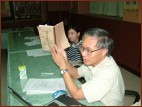 |
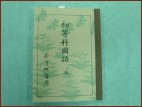 |
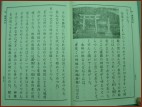 |
 |
| Professor
Tsai Jin-Tang |
Book 3, national
language textbook of primary level |
Lesson 9,
national language textbook of primary level |
Photo with
Professor Tsai |
| Information
provided by Professor Tsai Jin-Tang, National Taiwan Normal
University |
Website Translated
by Ou Yang Pei-ting(  Top )
Top ) |
|